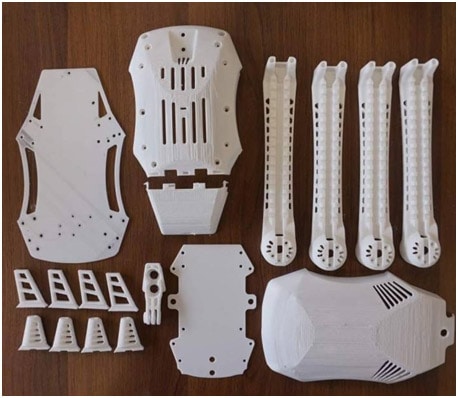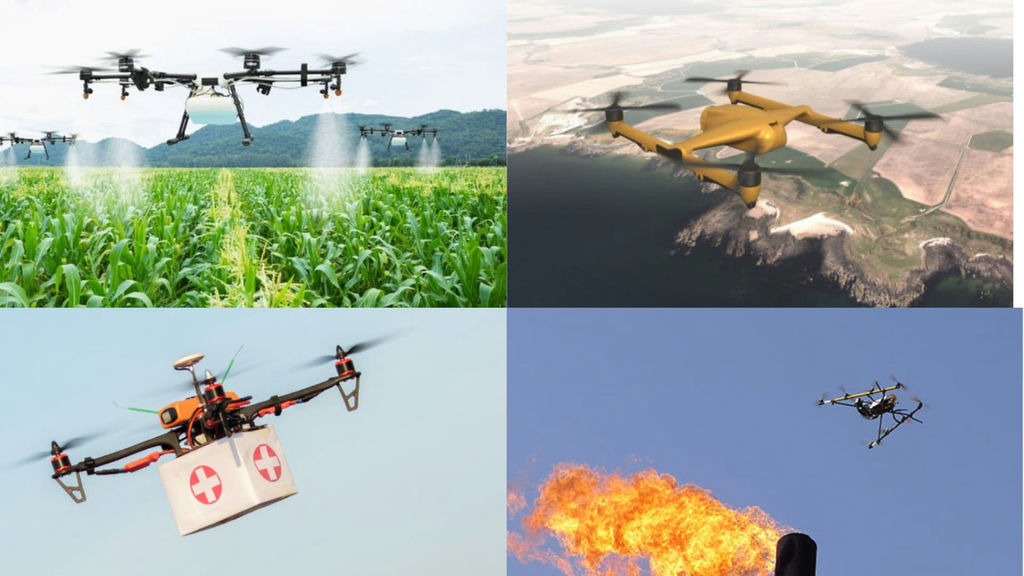Unmanned aerial vehicles (UAVs) and Urban Air Mobility (UAMs) such as drones and eVTOLs used for recreational, industrial and mobility purposes are a classic examples of how we can use technology to enrich our lives and solve many problems which were hitherto left unresolved or required taking on huge risks to solve them. Drones are used to survey areas which were thus far inaccessible, hazardous, needed aerial viewpoint, last mile cargo delivery, weather monitoring, delivering emergency medical supplies, agriculture seeding, search & rescue operations, disaster relief and the use cases are growing by the day. UAMs are used to carry passengers in over congested cities as air taxis. Drone application is not restricted to the military; during the past decade, it has increased significantly in both the commercial and mobility sectors. Drones will be a significant component of the 21st century economy due to their cutting edge capabilities and life cycle low cost of manufacturing and operations compared to the traditional methods.
3D printing or Additive Manufacturing is one of the Industry 4.0 innovations that will accelerate the drone revolution. The advancement of 3D printing technology makes it feasible to build necessary parts quickly, accurately, and economically for these UAVs. The benefits are advancing UAV technology for unheard of applications. In the aerospace and defence sectors, 3D printing has already been shown to be incredibly beneficial. Seven out of ten decision-makers in Jabil’s Aerospace and Defence Manufacturing Trends survey claimed that 3D printing had already altered their thinking and function.

When it comes to the production of drones, 3D printers serve as a “must have” technology. Several design limitations are being solved by this technique thereby unleashing the full creativity of the drone designers to come up with the most advanced solutions. The advantage of using additive manufacturing to develop drones is that almost every part of the assembly can be 3D printed, except for the electronic components. In addition to the main elements, many other accessories such as boosters, mounts, coverings and cases for properly storing the drones, can also be created.
With regard to creating these UAVs, 3D printing has several benefits.
Light Weight Components:
One of the main difficulties in UAV design and manufacturing is achieving an aerodynamic, minimal operational weight. A careful balance between weight and power is necessary for drones. They are battery-operated and require more power while hauling payloads. They need higher battery power to achieve desired distance, speed and altitude. However, larger batteries add weight. Therefore, other than electronic components, all structural components should be light weighted to compensate.
One of the versatile materials that can be 3D printed is Carbon Fiber Reinforced polymer (CFRP) aka carbon fiber composites (CFRC). CFRC by 3D printing is one of the methods that allows obtaining materials with high mechanical parameters at low density. Different types of carbon fibers viz. chopped and continuous can be incorporated into the component through 3D printing. For lightweight UAVs, composites provide various benefits. The density of carbon fiber, which is about 2 g/cm3, makes it naturally lightweight. Aluminum weighs 2.7 g/cm3, and titanium weighs 4.5 g/cm3. The matrix material for carbon fiber composites, which is often a thermoplastic substance, has a density of between 1 and 1.3 g/cm3 and encases the carbon fiber. Since carbon composites typically consist of 20% to 50% of carbon fiber, their combined density ranges from 1.2 to 1.5 g/cm3.
For example, a UAV frame 3D printed with continuous carbon fiber weighs 75g as compared to existing metal frames which weigh in the range of 130g to 230g with similar dimensions. And still, this 3D-printed frame can operate with a payload of up to 294 N. Apart from this, the whole frame can be fabricated as a single part which reduces the weight by eliminating the connecting hardware. Also, through Design for Additive Manufacturing (DfAM), the weight of the frame can be further reduced by optimizing the material usage.
Complex Design Fabrication and Fiber Arrangement:
Another major drawback of conventional layup composite manufacturing is design and assembly. The structure can become weaker when holes are drilled for fasteners to connect components, which might result in a large weight increase. Also, some complex structures cannot be made in a single piece using these traditional technologies. Using 3D printing, not only whole structure can be made in a single piece, but also it can print the complex geometry components that traditionally would require complex attachments. With the freedom of design from 3D printing, mechanisms and structures are now possible that were not possible previously to manufacture with conventional techniques.
In the CFRP components, usually, the load is carried out by the fiber (from 70-90% of the load), while rigidity & shape are provided by the matrix, which transfers the load to the fibers. However, one of the most important characteristics to take into consideration when working with composites is that their mechanical properties, such as strength, usually depend upon the direction of the applied load. However, this particular drawback can be eliminated using the 3D printing technique, fibers can be added in a particular direction and particular area as per the loading condition. So, fibers can be applied in that portion only where higher loading is expected, thus minimizing the fiber content, which ultimately helps from a cost point of view as well as weight consideration.
Materials for 3D printing drone components:
The choice of material used for 3D printing also plays an essential role in making the parts lightweight and yet have good mechanical, thermal and electrical properties. Drone manufacturers need to look into new material possibilities as drone use continues to increase. For instance, drones can be used in chimneys for inspection; firefighters may monitor and aid in the containment of wildfires using UAVs. However, in these cases, the material for the drone should be heat, smoke and chemical resistant. Specially engineered composite materials can be used in such types of applications.
Various thermoplastic polymers can be used to make drone components using 3D printing viz. ABS, Nylon, TPU etc. ABS is a robust and durable material that is used to make protective covers for drones. ABS has a density of 1.05 g/cm3 with 40 MPa tensile strength. Nylon is a strong and lightweight material that is used to make drone components as it retains its strength despite frequent use. It has a density of 1.12 g/cm3 with 55 MPa tensile strength. TPU (80A-90A shore hardness) is a flexible polymer material used to make special drone components without impacting performance. TPU has a density of 1.16 g/cm3 with 55 MPa tensile strength. However, due to high elongation (more than 500 %), it is ideal for many components where high performance is required. By adding chopped carbon fibers into the polymer matrix, the mechanical properties can be enhanced. Different reinforcement can also be added to the polymer matrix to achieve specific properties like electrical conductivity, thermal properties, flame retardant properties etc. By using continuous carbon fiber into the polymer or polymer with chopped fiber matrix, the part performance is enhanced to a great extent. Carbon fiber has a density of 1.4 g/cm3 with 800 MPa tensile strength. Therefore, by incorporating the continuous carbon fiber into the polymer matrix, the final 3D printed component is as strong as the Aluminium 6061.
On-Demand Manufacturing and Easy Upgradation:
Applications for drones in the military are wide-ranging, including intelligence, surveillance, target acquisition and reconnaissance. For drones working in these types of applications, maintenance and availability of spare parts are very important. The rapid adaption and new use cases of drone technology make it essential for manufacturers to deliver spare parts on demand. 3D printing can provide on-demand manufacturing with the shortest lead time. Apart from that, design iterations are very economical with 3D printing compared to traditional manufacturing processes. Parts can be manufactured with an upgraded design and fitted into the existing drones for better performance.
BRALCO’s solutions for Drone Manufactures
Bralco has developed a unique combination of very lightweight, high strength, and temperature resistant polymer composite 3D printed products with electrical and magnetic properties. In combination with in-house engineered high speed 3D printers and 3D printing composite filaments, Bralco can deliver a variety of drone components at a low cost, short lead time and with properties that far exceed the currently available materials.
Bralco can provide solutions for different components of drones from the vast variety of materials developed in-house. Bralco provides drone frame, antenna mounts, drone fins, protective drone cases, landing gear, propellers, camera mount and functional parts manufactured from the specially-designed materials as per the requirements. In addition to this, Bralco’s composites solutions can improve the UAV’s electromagnetic (EMI) performance. These systems need effective and dependable wireless or satellite connectivity with ground stations because they are unmanned. Bralco materials allow for fail safe communication while obstructing unwanted and harmful noise (EMI signals) from the external sources.
Drones are changing the world as we know it. There is no way to predict what the future may bring, but 3D printing technology and composite materials for drones are a game changer. Bralco’s materials and 3D printing capabilities are at the forefront of this revolution.
Subscribe to AM Chronicle Newsletter to stay connected: https://bit.ly/3fBZ1mP
Follow us on LinkedIn: https://bit.ly/3IjhrFq
Visit for more interesting content on additive manufacturing: https://amchronicle.com/



